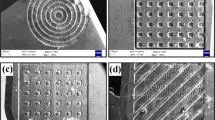Abstract
In this paper, the effects of different coolant supply strategies (using flood coolant, dry cutting, and minimum quantity of lubricant [MQL]) on cutting performance in continuous and interrupted turning process of Ti6Al4V are investigated. Based on the observation of the cutting forces with the different coolant supply strategies, the mean friction coefficient in the sliding region at the tool–chip interface has been obtained and used in a finite element method (FEM) to simulate the deformation process of Ti6Al4V during turning. From the FEM simulation and Oxley’s predictive machining theory, cutting forces have been estimated under different coolant supply strategies and verified experimentally.
Similar content being viewed by others
References
Zoya ZA, Krishnamurthy R (2000) The performance of CBN tools in the machining of titanium alloys. J Mater Process Technol 100:80–86 doi:10.1016/S0924-0136(99)00464-1
Weinert K, Inasaki I, Sutherland JW, Wakabayashi T (2004) Dry machining and minimum quantity lubrication. CIRP Ann 53(2):511–537
Rahman M, Kumar AS, Salam MU (2001) Evaluation of minimal quantities of lubricant in end milling. Int J Adv Manuf Technol 18(4):235–241 doi:10.1007/s001700170063
Rahman M, Kumar AS, Salam MU (2002) Experimental evaluation on the effect of minimal quantities of lubricant in milling. Int J Mach Tools Manuf 42(5):539–547 doi:10.1016/S0890-6955(01)00160-2
Wakabayashi T, Inasaki I, Suda S, Yokota H (2003) Tribological characteristics and cutting performance of lubricant esters for semi-dry machining. CIRP Ann 52(1):61–64
Sumitomo Electric Industries (2000) Performance cutting tools. Sumitomo Electric Industries, Japan
Sandvik Hard Materials (2001) Cemented carbide rod blanks for metal cutting. Sandvikens Tryckeri, Sweden
Paul S, Chattopadhyay AB (1995) Effects of cryogenic cooling by liquid nitrogen jet on forces, temperature and surface residual stresses in grinding steels. Cryogenics 35(8):515–523 doi:10.1016/0011-2275(95)98219-Q
Merchant ME (1944) Basic mechanics of the cutting process. ASME J Appl Mech 67:168–175
Oxley PLB (1989) The mechanics of machining: an analytical approach to assessing machinability. E. Horwood, Chichester, UK
Zorev NN (1963) Interrelationship between shear processes occurring along tool face and on shear plane in metal cutting. In: Proceedings of the Conference on International Research in Production Engineering, ASME, New York, pp 42–49
Ozel T (1998) Investigation of high speed flat end milling process: prediction of chip formation, cutting forces, tool stresses and temperatures. Ph.D. thesis, The Ohio State University, Columbus, OH
Johnson GR, Cook WH (1983) A constitutive model and data for metals subjected to large strains, high strain rates and high temperatures. In: Proceedings of the 7th International Symposium on Ballistics, The Netherlands, pp 541–547
Wang ZG, Rahman M, Wong YS, Li XP (2005) A hybrid cutting force model for high-speed milling of titanium alloys. CIRP Ann 54(1):71–74
Ozel T, Altan T (2000) Process simulation using finite element methodx—prediction of cutting forces, tool stresses and temperatures in high-speed flat end milling. Int J Mach Tools Manuf 40(5):713–738 doi:10.1016/S0890-6955(99)00080-2
Kops L, Arenson M (1999) Convective heat transfer coefficients in turning. In: Proceedings of the 15th Brazilian Congress of Mechanical Engineering, Sao Paulo, Brazil, CD-ROM
Wang ZG, Rahman M, Wong YS et al (2005) Modeling of cutting forces during machining of titanium alloys with different coolant strategies. In: Proceedings of the 8th CIRP International Workshop on Modeling in Machining Operations, Chemnitz, Germany, pp 275–282
ISO (1977) Tool-life testing with single-point turning tools, ISO 3685:1977, Annex G, 41
Chou YK, Evans CJ (1999) Cubic boron nitride tool wear in interrupted hard cutting. Wear 225–229:234–245 doi:10.1016/S0043-1648(99)00012-5
Author information
Authors and Affiliations
Corresponding author
Rights and permissions
About this article
Cite this article
Wang, Z.G., Rahman, M., Wong, Y.S. et al. Study on orthogonal turning of titanium alloys with different coolant supply strategies. Int J Adv Manuf Technol 42, 621–632 (2009). https://doi.org/10.1007/s00170-008-1627-x
Received:
Accepted:
Published:
Issue Date:
DOI: https://doi.org/10.1007/s00170-008-1627-x




